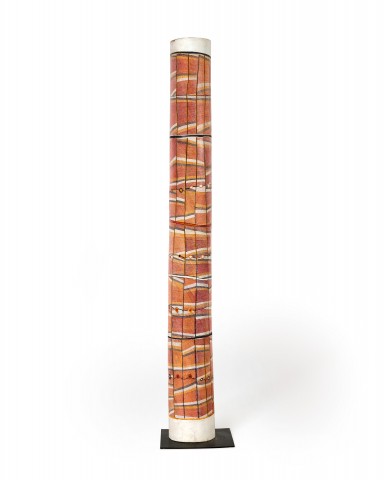UNTITLED (LORRKON), 2005
JOHN MAWURNDJUL
natural earth pigments and synthetic binders on hollow log
247.0 cm height
Maningrida Arts and Culture, Maningrida, Northern Territory (cat. 3037-05)
Annandale Galleries, Sydney
Private collection, Queensland, acquired from the above
Private collection, Melbourne
‘I also make make Lorrkon – hollow log – all painted with my rarrk, filled with Mardayin power.’1
Untitled (Lorrkon), 2005 was painted the year before John Mawurndjul undertook his major commission for the Musée du Quai Branly, Paris. As one of the eight Australian artists selected by the project architect Jean Nouvel to integrate Australian indigenous art into the structure of the building, Mawurndjul was commissioned to paint a colossal column and another of his works was reproduced on the ceiling of the museum bookshop. Although highly sacred by nature, Mawurndjul chose to depict Mardayin ceremonial themes on the Branly column and indeed our Lorrkon also depicts an abstract representation of this ancient ceremony.
The Western Arnhem Land version of the Lorrkon ceremony involves the singing of sacred songs to the accompaniment of the karlikarli, a pair of sacred boomerangs used as rhythm instruments. The complete ceremony may stretch over a period of two weeks, but on the last night the bones of the deceased – which have been kept in a bark container or today wrapped in cloth and kept in a suitcase – are taken out, painted with red ochre and placed inside the hollow log. This ceremony may take place years after the person has died.
‘At the end of the ceremony, early in the morning as the sun moves across the sky, the hollow log is placed upright. It will stand there and decay. At the end of standing-up ritual the women will dance around it. In the camp people chant as they move up. The section with men carrying burning torches represent the fire hawks who carry the burning embers and take them away… Fire Hawks or brown falcons carry the fire in the ceremony representing the hawk lifting up that person and taking them away.’2
1. Kohen, A., ‘Interview with Apolline Kohen and John Mawurndjul’ in Kaufmann, C. and Museum Tinguely, Basel (eds.), rarrk: John Mawurndjul: Journey through Time in Northern Australia, Schwabe Verlag, Basel and Crawford House, Adelaide, 2005, p. 28
2. Mawurndjul, cited in John Mawurndjul, I am the Old and the New, Museum of Contemporary Art, Sydney, 2018, p. 283
CRISPIN GUTTERIDGE
